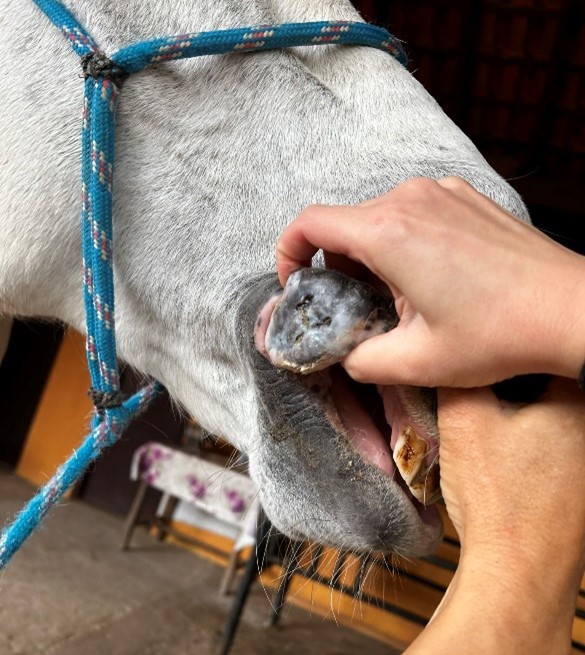Fine-needle aspiration as a diagnostic tool for melanocytic cell tumor in a grey horse
Case report
DOI:
https://doi.org/10.31533/pubvet.v19n02e1731Keywords:
Grey horse, FNA, melanocytic tumorAbstract
Melanocytic cell tumors, commonly known as melanomas, are frequently observed in grey horses, especially in older animals. These tumors can range from benign to malignant and are often diagnosed in areas such as the base of the tail, perineum, lips, and parotid glands. Fine-Needle Aspiration (FNA) has proven to be a valuable diagnostic tool in the evaluation of neoplasms, allowing for the collection of tumor cells for cytological analysis in a minimally invasive and cost-effective manner for many owners. This case report describes the use of FNA in diagnosing a benign melanocytic tumor in a 15-year-old grey horse that presented a subcutaneous mass in the submandibular region, as well as formations at the base of the tail and lips. After collecting the material via FNA, the samples were subjected to cytological analysis, where no malignancy criteria were observed. Since surgical intervention and histopathological evaluation were not opted for, treatment with Cimetidine was initiated to reduce the tumor masses. The application of FNA proved to be an efficient and practical technique in obtaining diagnostic material, allowing for early tumor identification and aiding in the clinical management of the patient. This report reinforces the importance of FNA as a diagnostic tool in veterinary medicine, especially in cases of cutaneous neoplasms in horses, where quick and accurate interventions are essential for successful treatment.
References
Aung, P. P., Maarit-Sarlomo-Rikala, J. L., Lai, J., Wang, Z.-F., & Miettinen, M. (2012). KBA62 and PNL2: 2 new melanoma markers-immunohistochemical analysis of 1563 tumors including metastatic, desmoplastic, and mucosal melanomas and their mimics. The American Journal of Surgical Pathology, 36(2), 265–272. https://doi.org/10.1097/PAS.0b013e31823651cb.
Camargo, L. P., Conceição, L. G., & Santos Costa, P. R. (2008). Neoplasias melanocíticas cutâneas em cães: estudo retrospectivo de 68 casos (1996-2004). Brazilian Journal of Veterinary Research and Animal Science, 45(2), 138–152.
Goldschmidt, M. H., & Goldschmidt, K. H. (2017). Epithelial and melanocytic tumors of the skin. In D. J. Meuten (Ed.), Tumors in Domestic Animals (pp. 88–141). John Wiley & Sons Inc.
Kuznitzky, R., Garay, I., Kurpis, M., & Lascano, A. R. (2003). Melanoma amelanótico. Medicina Cutánea Ibero-Latino-Americana, 31(3), 202–205.
Lavalle, G. E., Araújo, R. B., Carneiro, R. A., & Pereira, L. C. (2003). Punção aspirativa por agulha fina para diagnóstico de mastocitoma em cães. Arquivo Brasileiro de Medicina Veterinária e Zootecnia, 55(4), 500–502. https://doi.org/10.1590/s0102-09352003000400017.
Metcalfe, L. V. A., O’Brien, P. J., Papakonstantinou, S., Cahalan, S. D., McAllister, H., & Duggan, V. E. (2013). Malignant melanoma in a grey horse: Case presentation and review of equine melanoma treatment options. Irish Veterinary Journal, 66(1), 22. https://doi.org/10.1186/2046-0481-66-22.
Moore, J. S., Shaw, C., Shaw, E., Buechner-Maxwell, V., Scarratt, W. K., Crisman, M., Furr, M., & Robertson, J. (2013). Melanoma in horses: Current perspectives. Equine Veterinary Education, 25(3). https://doi.org/10.1111/j.2042-3292.2011.00368.x.
Nowacka-Woszuk, J., Mackowski, M., Stefaniuk-Szmukier, M., & Cieslak, J. (2021). The equine graying with age mutation of the STX17 gene: A copy number study using droplet digital PCR reveals a new pattern. Animal Genetics, 52(2). https://doi.org/10.1111/age.13044.
Pimenta, J., Prada, J., & Cotovio, M. (2023). Equine melamocytic tumors: A narrative review. Animals, 13(2), 247. https://doi.org/10.3390/ani13020247.
Ramos-Vara, J. A., Frank, C. B., DuSold, D., & Miller, M. A. (2014). Immunohistochemical Expression of Melanocytic Antigen PNL2, Melan A, S100, and PGP 9.5 in Equine Melanocytic Neoplasms. Veterinary Pathology, 51(1). https://doi.org/10.1177/0300985812471545.
Reed, S. M., Bayly, W. M., & Sellon, D. C. (2009). Equine internal medicine. Elsevier Health Sciences.
Reed, S. M., Bayly, W. M., & Sellon, D. C. (2022). Medicina interna equina. Guanabara Koogan S.A.
Schobert, C. S., Labelle, P., & Dubielzig, R. R. (2010). Feline conjunctival melanoma: Histopathological characteristics and clinical outcomes. Veterinary Ophthalmology, 13(1), 43–46. https://doi.org/10.1111/j.1463-5224.2009.00758.x.
Seltenhammer, M. H., Simhofer, H., Scherzer, S., Zechner, P., Curik, I., Sölkner, J., Brandt, S. M., Jansen, B., Pehamberger, H., & Eisenmenger, E. (2003). Equine melanoma in a population of 296 grey Lipizzaner horses. Equine Veterinary Journal, 35(2). https://doi.org/10.2746/042516403776114234.
Šerman, N., Vranić, S., Glibo, M., Šerman, L., & Mokos, Z. B. (2022). Genetic risk factors in melanoma etiopathogenesis and the role of genetic counseling: A concise review. Bosnian Journal of Basic Medical Sciences, 22(5). https://doi.org/10.17305/bjbms.2021.7378.
Silva, K. L. F. (2013). Estudo da proliferação celular em tumores melanocíticos caninos. In Departamento de Vetrinária: Vol. Master of.
Yi, Z., Gao, Y., Yu, F., Zhu, Y., Liu, H., Li, J., & Murua Escobar, H. (2023). Interventions for treatment of cutaneous melanoma in horses: A structured literature review. Veterinary Research Communications, 47(2), 347–360. https://doi.org/10.1007/s11259-022-10023-8.

Downloads
Published
Issue
Section
License
Copyright (c) 2025 Nicoli Guimarães Borges

This work is licensed under a Creative Commons Attribution 4.0 International License.
Você tem o direito de:
Compartilhar — copiar e redistribuir o material em qualquer suporte ou formato
Adaptar — remixar, transformar, e criar a partir do material para qualquer fim, mesmo que comercial.
O licenciante não pode revogar estes direitos desde que você respeite os termos da licença. De acordo com os termos seguintes:
Atribuição
— Você deve dar o crédito apropriado, prover um link para a licença e indicar se mudanças foram feitas. Você deve fazê-lo em qualquer circunstância razoável, mas de nenhuma maneira que sugira que o licenciante apoia você ou o seu uso. Sem restrições adicionais
— Você não pode aplicar termos jurídicos ou medidas de caráter tecnológico que restrinjam legalmente outros de fazerem algo que a licença permita.




